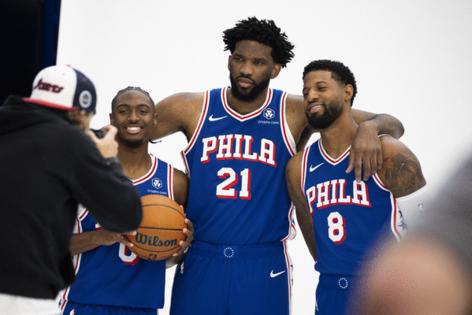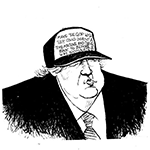The Sixers are committed to the superteam path. Could they be on a trajectory that no longer exists?
Published in Basketball
PHILADELPHIA — Last summer, the 76ers made decisions that could ultimately set the franchise back for years to come.
They signed Paul George to a maximum-salary free-agency deal and gave Joel Embiid a supermax extension with the goal of building a superteam. But the All-Star trio of Tyrese Maxey, Embiid and George missed a combined 134 games and came with a large price tag.
Simultaneously, the NBA standard for success changed once again — and the era of the superteam died with that shift. Now, teams at the mountaintop have maybe two superstars and a good cast of role players.
The Indiana Pacers and Oklahoma City Thunder, small-market teams set to face off in the NBA Finals, were built through youth movements and cohesion. They did it without a lot of flashy free-agent signings or blockbuster trades.
That’s not to say these teams were built completely through the NBA draft. The Pacers’ All-Star duo of Tyrese Haliburton and Pascal Siakam were landed through trades. Ditto for the Thunder’s Shai Gilgeous-Alexander, the league’s recently crowned MVP.
But both squads were constructed organically, and their rosters quickly created chemistry that allowed them to develop into contenders.
Pacers center Myles Turner, who has spent his entire 10-year career in Indiana, spoke about the importance of that time together.
“I think it’s a new blueprint for the league, man,” Turner told the media Saturday after a series-clinching 125-108 win over the New York Knicks in Game 6 of the Eastern Conference finals.
“I think the years of superteams and stacking, it’s not as effective as it once was,” he continued. “Since I’ve been in the league, this NBA is very trendy. It just shifts. The new trend is what we’re doing. OKC does the same thing. Young guys get out and run, defend and use the power of friendship is how they call it.”
The Boston Celtics were a superteam from 2007-12 after acquiring Kevin Garnett and Ray Allen to play with Paul Pierce. So were the Miami Heat from 2010-14, thanks to LeBron James and Chris Bosh joining forces with Dwyane Wade. And the Golden State Warriors had arguably the greatest superteam from 2016-19 after Kevin Durant left the Thunder to play alongside Steph Curry and Klay Thompson. All three of those franchises are success stories that were spearheaded by a trio of future and/or current Hall of Famers.
The Celtics won the 2008 NBA title before losing to the Los Angeles Lakers in the 2010 Finals. The Heat won consecutive championships in 2012 and 2013 while making four straight Finals appearances. And the Warriors won the 2017 and 2018 crowns before succumbing to injuries in a 2019 Finals loss to the Toronto Raptors. Durant ruptured his Achilles tendon in Game 5 and Thompson suffered a torn ACL in his left knee in Game 6.
In 2021, Durant headed to the Brooklyn Nets along with Kyrie Irving and, eventually, James Harden to create, on paper, one of the greatest superteams of all time. But the group lasted only two years and became a disaster because of injuries and poor culture.
The drama caused Harden to force a trade to the Sixers on Feb. 10, 2022. Irving and Durant eventually also sought different opportunities. Irving was traded to the Dallas Mavericks on Feb. 6, 2023. Three days later, Durant forced a trade to the Phoenix Suns.
The trio’s only significant moment in Brooklyn was losing a 2021 second-round series to the Milwaukee Bucks in seven games.
But when the three all played together, the Nets were 13-3. The trio rarely had an opportunity to build cohesion. Irving missed 123 games during his Brooklyn tenure. Durant missed 79 games, while Harden played in 80 games.
The Suns played through multiple Big Three eras. Durant joined Devin Booker and Chris Paul in Phoenix for one season and a second-round playoff appearance. The franchise then began an unsuccessful superteam era by acquiring Bradley Beal via a trade from the Washington Wizards on June 4, 2023. The Big Three of Devin Booker, Durant and Beal have one playoff appearance — in which they were swept in four games by the Minnesota Timberwolves — in two seasons together.
Yet the Suns had the league’s highest payroll of $214.3 million this season. They’re projected to have the second-highest ($218.7 million) in 2025-26, thanks in large part to Durant ($54.7 million), Beal ($53.6 million) and Booker ($53.1 million) having maximum-salary deals, according to spotrac. Exceeding the salary cap’s second-apron threshold ($207.8 million) for next season, Phoenix is restricted in its ability to make trades.
The NBA’s second apron, a more restrictive financial threshold for teams, was introduced with the 2023 collective bargaining agreement and took full effect last summer.
The initial penalty for teams over the second apron is the loss of a mid-level exception. In addition, second-apron squads can no longer make trades in which they send out more salary than they take in. Nor can they send cash in trades or trade a first-round pick seven years out. As a result, the Suns will be hamstrung for several seasons unless they find a way to break up their failing Big Three.
The Sixers could have similar problems because of last summer’s transactions.
They already have $149.1 million in guaranteed salary allocated to four players — the Big Three and Jared McCain — next season with the bulk of the money going to Embiid ($55.2 million), George ($51.6 million) and Maxey ($37.9 million).
The problem is that the league’s projected salary cap for the 2025-26 season is around $154.6 million, and the luxury tax threshold is projected to be around $187.9 million. The Sixers’ bigger problem as they look to re-sign other key contributors is how close they sit to the first ($195.9 million) and second luxury-tax aprons.
But looking to make a free-agency splash, the Sixers signed George to a four-year, $211.5 million maximum salary contract in July. That month, they also signed Maxey to a five-year, $203.8 million maximum salary. And in September, the Sixers signed Embiid to a three-year, $192.9 million maximum extension that will keep him under contract through the 2028-29 season. The 31-year-old is set to make $69 million in the final year of his deal.
That’s a lot of money for someone who played in just 58 games over the last two seasons. Embiid, who had arthroscopic surgery on April 11 to help with his ailing left knee, played in only 19 games this season.
Meanwhile, George received injections in the left adductor muscle in his groin and his left knee on March 17. The nine-time All-Star, who played in 41 games, was ruled out for the rest of the season after the injections. Embiid was ruled out for the remainder of the season on Feb. 28.
In addition to the Sixers being in salary-cap hell, Embiid and George have hard-to-move contracts and uncertain futures in an era when superteams are becoming obsolete.
But on Thursday, the Pacers and Thunder will participate in Game 1 of an NBA Finals featuring two of the league’s most frugal championship contenders.
This marks the first championship series since 2003 — the year the luxury tax was implemented — in which neither team is a luxury-tax payer.
Indiana spent $169 million on this season’s roster, which includes $42.1 million each for All-Stars Haliburton and Siakam. The Thunder have a combined salary of $165 million, with Gilgeous-Alexander making $35.8 million and Isaiah Hartenstein making $30 million.
The age of stacking high-priced superstars is over. It’s about stacking fit and developing talent.
The Pacers and Thunder are proof, and the Sixers are on the path to being left behind.
©2025 The Philadelphia Inquirer. Visit inquirer.com. Distributed by Tribune Content Agency, LLC.







Comments